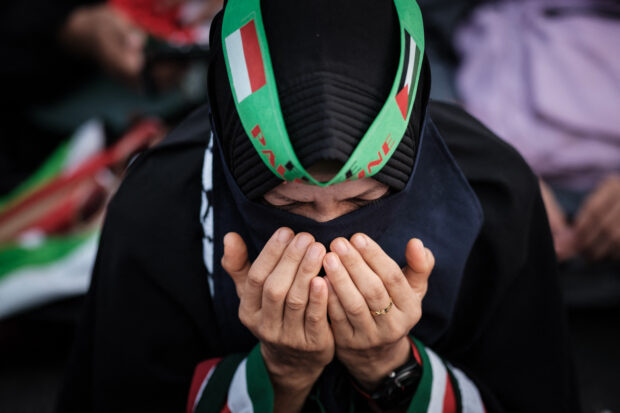10 key developments since the October 7 attacks on Israel

PARIS — After Palestinian militant group Hamas carried out the deadliest attack in Israeli history on October 7, 2023, Israel responded with a devastating military campaign in the Gaza Strip.
The air and ground operation has killed more than 41,700 people, according to the Hamas-ruled territory’s health ministry, whose figures are considered reliable by the United Nations.
Ahead of the war’s first anniversary, AFP looks back at key moments.
Hamas attacks
At dawn on October 7, hundreds of Hamas fighters infiltrate Israel.
READ: Israel on alert ahead of Hamas attack anniversary
Article continues after this advertisement
The unprecedented attack results in the deaths of 1,205 people, mostly civilians, according to an AFP tally of Israeli official figures.
Article continues after this advertisement
This toll includes hostages who subsequently died or were killed in captivity in the Gaza Strip.
Hamas took 251 hostages back to Gaza, some as corpses. A year later, some 64 are still detained, while 117 have been freed and 70 confirmed dead.
Israeli Prime Minister Benjamin Netanyahu vows to destroy Hamas, which is blacklisted as a “terrorist” organization by the European Union and the United States.
Ground offensive
Israel begins bombing Gaza and further tightening its siege of the territory. On October 13, it tells civilians in northern Gaza to move south.
The United Nations later estimates that nearly all of Gaza’s population of 2.4 million is eventually displaced.
READ: A nation in pain: Israelis a year after October 7
On October 27, Israel launches a ground offensive.
On November 15, its troops raid Gaza’s biggest hospital, Al-Shifa, where Israel says Hamas has a command centre, an accusation the militants deny.
Truce and hostage swap
On November 24, a weeklong truce between Israel and Hamas takes effect.
Hamas releases 80 Israeli hostages in return for 240 Palestinians held in Israeli prisons. Twenty-five other hostages, mainly Thai farm workers, are also freed.
Israel allows more aid into Gaza via Egypt, but the humanitarian situation there remains dire.
When fighting resumes, Israel expands its actions into southern Gaza.
Aid hitches
On February 29, Gaza’s health ministry says 120 northern Gaza residents were shot dead by Israeli forces as they rushed towards a convoy of food aid. Israel says soldiers believed they “posed a threat”.
From early March, several countries airdrop aid into Gaza. A first aid ship from Cyprus arrives on March 15.
On April 1, seven aid workers from the US charity World Central Kitchen are killed in an Israeli strike, which the military calls a “tragic mistake”.
Israel-Iran tensions
On April 13, Iran pounds Israel with drones and missiles in retaliation for a deadly strike on its consulate in Damascus blamed on its arch-enemy.
Most of the projectiles are intercepted.
Operations in the south
On May 7, the Israeli army launches a ground offensive in Rafah, Gaza’s southernmost city, where a majority of the territory’s people have sought shelter.
READ: Israel faces global outcry over Rafah strike that set tent city ablaze
It takes control of the border crossing with Egypt, blocking a key entry point for aid, and targets safe areas including tent camps and schools sheltering displaced people.
On July 13, a strike in southern Gaza kills the chief of Hamas’s armed wing, Mohammed Deif, Israel says.
Regional flare-up feared
On July 20, Israel attacks Yemen in retaliation for a deadly drone strike on Tel Aviv by the Iran-backed Huthi rebels, who have repeatedly attacked Red Sea and Gulf of Aden shipping in solidarity with Gaza.
On the Israel-Lebanon border, almost daily exchanges of fire between the Israeli army and Iran-backed militant group Hezbollah intensify.
On July 27, in the Israeli-annexed Golan Heights, 12 children are killed in a rocket strike. Hezbollah denies responsibility.
Hezbollah’s top commander, Fuad Shukr, is killed in a Beirut suburb on July 30 in a retaliatory strike.
The next day, Hamas political leader Ismail Haniyeh is killed in a strike in Iran, blamed on Israel. Hamas names Yahya Sinwar, its leader in Gaza, to replace him.
Truce talks
Washington on August 16 presents a new truce deal, which Hamas immediately rejects. Negotiations mediated by Egypt, then Qatar, resume on August 22.
On August 25, Israel says it has thwarted a large-scale Hezbollah attack with air strikes into Lebanon. Hamas says it successfully launched hundreds of rockets and drones at Israel.
West Bank raid
On August 28, Israel launches a major operation against Palestinian militants in the occupied West Bank.
The UN calls for an immediate end to the raid.
After the military recovers the bodies of six hostages from Gaza on August 31, pressure mounts on the Israeli government to secure the release of the remaining captives, but Netanyahu does not budge over a truce.
Lebanon attacks
On September 17 and 18, thousands of Hezbollah members’ pagers and walkie-talkies explode across Lebanon, killing at least 39 people and wounding almost 3,000.
Israel had announced it was expanding its Gaza war aims to include securing the northern front with Lebanon, but does not claim responsibility.
Amid a mounting series of bombardments against Hezbollah, on September 27, an Israeli strike on its south Beirut stronghold kills the group’s leader Hassan Nasrallah alongside an Iranian general in the Revolutionary Guards.
Iran’s Supreme leader Ayatollah Ali Khamenei vows that Nasrallah’s death “will not be in vain”.
On October 1, Iran launches a barrage of missiles at Israel in what the Revolutionary Guards say is a response to the killings of Nasrallah and Haniyeh.
The attack comes the day Israel announced limited ground operations against Hezbollah in southern Lebanon. More than 1,900 people have also been killed in Lebanon since Hezbollah and Israel began clashing last October, according to Lebanon’s health minister.